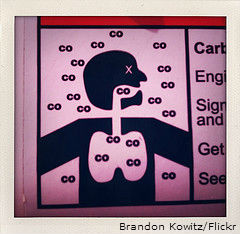Carbon monoxide is a colorless, odorless gas that is the leading cause for accidental poisoning deaths. However, many of these deaths are easily preventable by installing a carbon monoxide detector. Protect your family and install a carbon monoxide detector in your home today.
What is carbon monoxide?
You may have heard of carbon monoxide before but aren't really sure what it is -- only that it's dangerous. Carbon monoxide is a colorless, odorless and tasteless toxic gas that results from faulty combustion in appliances like a furnace, water heater, car exhaust, portable camping stoves and many other appliances.
The gas is produced during the incomplete combustion of fuel - natural gas, oil, coal, wood, kerosene, etc.--and cannot be detected without the use of a carbon monoxide detector.
The gas is so dangerous because as it leaks from its source, it slowly replaces the oxygen in the area and makes it difficult to breathe leading to (in light concentrations) headaches and dizziness and (in higher concentrations) unconsciousness and death. In high concentrations, 12,800 ppm (1.28 percent) death can occur in less than three minutes.
Detectors
If you already have smoke detectors in your home, you may only need to upgrade them to combination smoke and carbon monoxide detector alarms. Many combination detector models even have voice notification that will alert you if the threat is a fire or carbon monoxide.
All home detectors use an audible alarm signal as their primary indicator, however some versions also offer a digital reading of the CO concentration in parts per million. Digital CO detectors have advantages over standard detectors because they can keep a history of levels and concentrations and even alert you to high levels during your absence.
Placement of CO detector
Proper placement of a CO detector is crucial, and if you only plan on installing one detector, install it near your sleeping area so it will wake you if you and your family are asleep. Installation will vary by manufacturer so be sure to read the directions thoroughly before beginning.
For the most part, you SHOULD NOT install a carbon monoxide detector in a humid area like a bathroom or within 15 feet of heating or cooking appliances.
These locations are best for placement:
- On each floor of the home including basements and finished attics
- In each bedroom
- In each hallway close to sleeping areas- if the hallway is longer than 40 feet place a device at both ends
- At the top of stairways
Installation
Battery-powered detector alarms are the easiest to install, but make sure to check and replace the batteries regularly. Other alarms connect to your home's electrical system -- you should look for models with battery backup. If you choose CO detectors that are hardwired into your electrical system, contact an electrician or home contractor to install them for you so you can ensure they are installed correctly. It will be less dangerous for an untrained homeowner.
To install a battery operated alarm:
- Install the batteries in the unit on the back of the device following the manufacturer's directions.
- Position the unit on the ceiling or an inside wall and using the unit as a guide, mark the edges of the unit and mark the center of the holes with a pencil.
- Drill a hole through each of the pencil marks.
- Install anchors in the holes with a hammer. (Anchors may not be necessary if the screw holes are into a ceiling rafter or wall stud).
- Insert screws and tighten until the back plate is secure.
- Attach the detector-alarm unit to the back plate.
- Test the unit to verify that it operates and can be heard. Test it each week as per manufacturer's instructions.
IMPORTANT: If your alarm sounds at any time, open as many windows as you can to ventilate the area and your home and evacuate. Call 911 to report the problem and stay out of the house until fire personnel or technicians tell you it's safe to return.